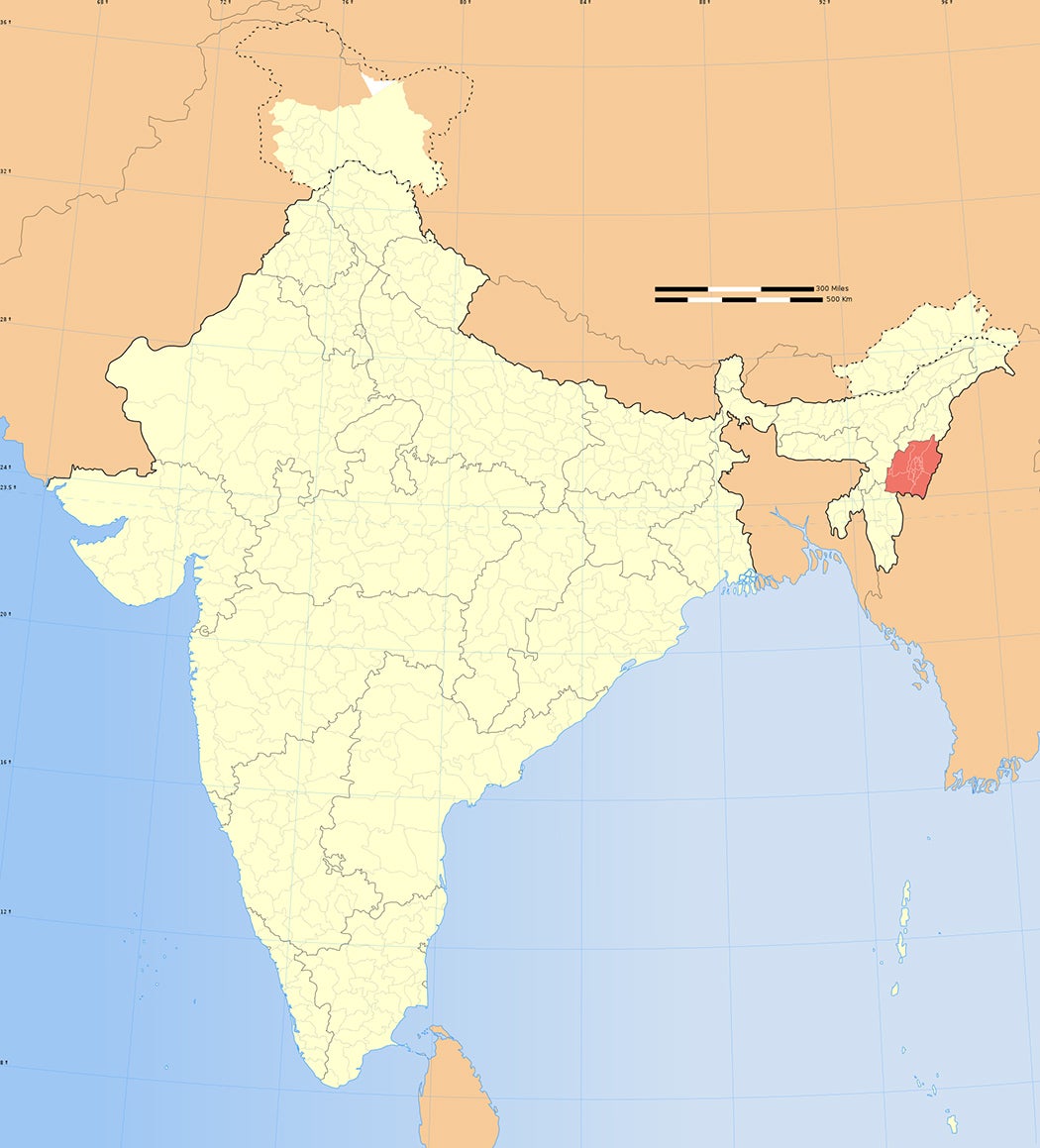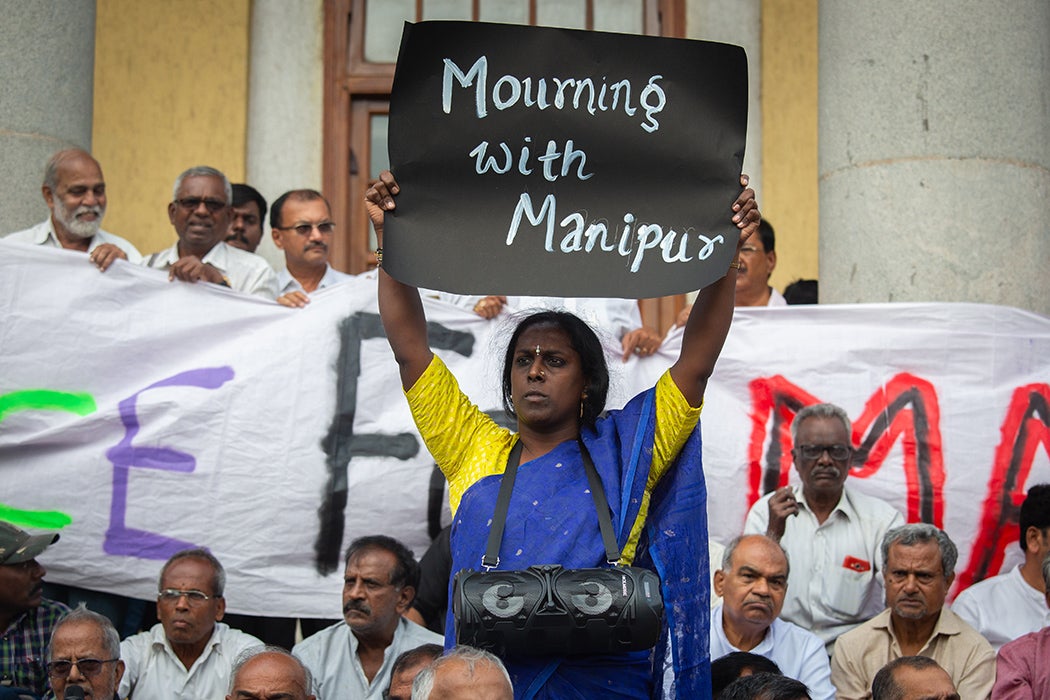The first time the world took notice of the gross human rights violations being perpetrated in Manipur, India, was in July 2023, when a video of Manipuri women from the Kuki tribe who had been tortured, raped, and paraded around naked went viral on social media. These heinous acts came on the heels of the tremendously violent communal conflict that engulfed Manipur earlier in the year.
In reality, the violence follows a long and fraught socio-political history. The region has been prone to ethnic violence for decades, ever since the king of Manipur, Bodhachandra, signed an accord with the Government of India to become a part of the newly independent nation of India in 1949. The traditional conflict was between the Naga and Kuki tribes, but the recent violence has been between the Meiteis and Kukis.

Vibha Arora and Ngamjahao Kipgen explain the origin of these ethnic groups and their conflicts in their paper, “The Politics of Identifying with and Distancing from Kuki Identity in Manipur,” published in 2012 in the Sociological Bulletin. Historically, the Meitei dynasty ruled the independent kingdom of Manipur. After Manipur formally joined India, it was administered as a “C” scheduled state, along with nine other states, including Ajmer, Bhopal, and Himachal Pradesh. Unlike “A” states, which were overseen by an elected governor, “C” states were governed by chief commissioners appointed by the President of India. Manipur became a Union Territory (e.g., a territory governed by the federal government) in 1956 and a finally full state, with elected governors, in 1972.
Arora and Kipgen describe Manipur as “a multi-ethnic society inhabited by three main ethnic groups—namely, the Nagas, the Kukis, and the Meiteis—who occupy distinct territories and topographies.” Manipur’s highlands are the domain of “Christianized Naga and Kuki tribes who constitute about 34 per cent of the total population,” with the Nagas living in the northern mountains and the Kukis in the southern hills. “[T]he valley areas are largely inhabited by the Meiteis, who are predominantly Hindu,” they note. Other tribes, including the predominantly Muslim Pangans, live in Manipur as well, but the conflicts between the Naga, Kuki, and Meitei tribes shape the social landscape. Over the years, the permutations and combinations of clashes between constituents may have changed, but the violence continued unabated.
In his paper “Armed Violence in Manipur and Human Rights,” published in The Indian Journal of Political Science in 2011, Oinam Jitendra Singh points towards three prominent reasons for this. The first, he says, is political.
“The basic structural violence in Manipur today, at the political plane,” he argues, “is the total denial of a democratic space to the Manipuri people at the ground level for such a long time.” In other words, the Manipur monarchy was forced to transition to a “C” state, after which “a corrupt bureaucracy accountable to Delhi was running the show.”
The second factor is economic. Manipur came into India with an almost entirely agrarian economy, with a surplus of rice. After the merger, household industries declined as the economy was managed centrally. As Singh argues,
[t]he opportunity to build an economy with a strong productive base was wasted by the corrupt bureaucracy here [Manipur] on the one side and by the remote controlled, centralized planning on the other. There was no room for local initiatives.
And finally, the third reason Singh offers for the conflict is social, caused by the influx of immigrants following the assimilation of Manipur into India. The state’s population rapidly increased with the arrival of new residents from mainland, with the demographic shifts leading to structural change that
alarmed the indigenous population. They naturally feel that their distinctive culture and identities are facing a grave threat from the Indo-Aryan peoples of being submerged under or assimilated by them.
Singh shows that these factors led to the rise of secondary violence in the late 1970s, as armed opposition groups, soon to be labelled “terrorist organizations,” developed along ethnic lines. As a result, the Parliament of India instituted the Armed Forces Special Powers Act of 1958, authorizing the Commissioner of Manipur to use armed forces to maintain public order. But the arbitrary and heavy-handed use of the Special Powers Act led to the “unfettered use of force even against innocent civilians,” he writes, with “gross human rights violations including torture, extra-judicial execution, rape and enforced disappearances.”
Arora and Kipgen add to this, explaining that armed insurgencies are a common way to claim ethnic homelands, followed by “negotiating with the state and the national governments, and signed accords.” That being said, few of those signed accords “have engendered durable peace and participatory development.” They wonder,
How many ethnic groups are really assessing the success of their political elites in facilitating development and trickling down resources after the formation of exclusive homelands? […] While particular insurgents disappear or get absorbed into the political mainstream, insurgency per se does not decline, as other insurgents arise.
Insurgency can be a profitable business, they note, but it just leads to more disorder.
Ch. Sekholal Kom’s “Ethnic Mobilization and Militance in Northeast India: A Case of Manipur,” published in The Indian Journal of Political Science in 2010, had already highlighted the role of ethnic mobilization in militant formations in Manipur. As Kom notes, the defining of one ethnic group “kindled and accentuated the ethnic identity of another group.”
The idea of “ethnic identity” acted as a contagion, he explains. “The prospect of greater autonomy for one group stimulated similar demands from other groups.” Should one group be awarded political power and resources based on ethnicity, why should they not also go to another group?
“Most of the political developments in Northeast, from reorganization to protracted violence, are intrinsically linked to the question of ethnicity,” he writes. Ethnic differences—and the mobilization of those differences in the context of Manipur’s politics—has led to what he describes as “ethnic militancy” in the region. “These ethnic militants…have become the most resorted means for ethnic assertion and bargaining and even to the extent of achieving economic political power.”
Kom sees ethnic militancy as “one of the most serious threats to peace, security and development” in the region. Moreover, the instability and violence has been made even worse by the state, which “has failed to contain militancy through negotiations, dialogues and peace accords and instead countered by launching a massive counter insurgency offensive through its military and intelligence.” Insurgency begets insurgency.
Weekly Newsletter
Kom offers a solution to the government of Manipur, requesting that they address ethnic aspirations by providing autonomy to each group in a guided manner so that conflicts may be reduced. He ends with poignant advice that rings especially true in today’s context, pointing out that that a “resolution requires that a meaningful and acceptable political arrangement…meet[s] competing ethnic demands.” The state must demonstrate that it’s “serious in finding a lasting solution despite the many odds that would be inevitable.”
In other words, writes Kom, the Government of Manipur, like all parties involved in the conflict and resolution, needs “to tread all tracks and walk the talk.”







